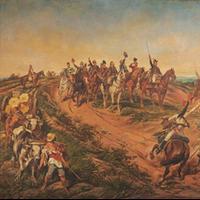Independência ou Morte (1888)
Também conhecida por Grito do Ipiranga, a pintura de 4 metros de altura e sete de largura, foi feita por Pedro Américo em 1888, em óleo sobre tela, e representa o momento da proclamação de independência do Brasil por Dom Pedro I ao redor do riacho do Ipiranga. Entretanto, é uma representação idealizada pelo pintor, já que não reproduz fielmente o evento. A cena se passa em um terreno com grama e estreitas estradas de terra; há um leve morro no segundo plano. O céu é azul e há diversas nuvens. Em terceiro plano, está ilustrada uma casa simples de cor marrom claro. Em último plano também há pequenos trechos de plantações. Em geral, predominam o branco e os tons de verde e marrom. No centro da pintura está Dom Pedro I erguendo sua espada e montado em um cavalo marrom. Ele está no topo do morro do segundo plano, no centro do quadro. Atrás dele há um grupo de homens, também em cavalos; alguns deles erguem seus chapéus, replicando o movimento feito pelo imperador. Todos vestes roupas típicas da corte, com botas e coletes, indicando que fazem parte do círculo da nobreza. E frente ao imperador, há um grupo grande de soldados. Eles vestem fardas em branco e vermelho, e levantam suas espadas. Estão montados em cavalos que transmitem a ideia de movimento.
Do lado oposto, à esquerda do imperador, há um homem. Ele está descalço, com roupas simples, que eram usadas para o trabalho nas fazendas, além de um chapéu de palha. Ele olha para Dom Pedro, posicionado no caminho até o topo do morro, em primeiro plano.

